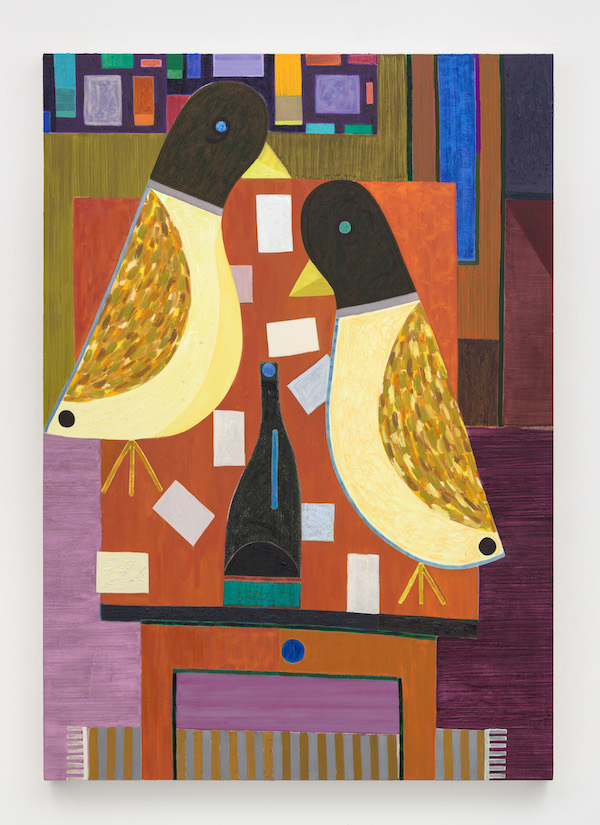
NEWPORT, R.I. – Games, Gamblers & Cartomancers: The New Cardsharps, on view at the Vernon House until September 30, brings together 17 contemporary artists who have revisited the art-historical trope of card play.
Card-playing is rooted in Newport’s history — historically and contemporarily, card-playing has been and remains part of the social fabric. Newporter Edith Wharton’s protagonist Lily Bart in House of Mirth describes her gambling debts incurred at the high society bridge tables. To this day, bridge games and canastas are the norm three times a week. As with all of Art & Newport’s projects, the curators have sought to highlight the enduring social customs of the town while simultaneously injecting local history and tradition with contemporary artistic interpretations.
Card games cut across cultures and social classes — using cards for entertainment, gambling, divination and education goes back centuries. The first known reference to card-playing appears in Chinese literature of the 10th century. In Europe, card play emerged in Italy and Spain in the 1370s and is believed to be a product of the cultural diffusion engendered by trade between Europeans and the Muslim world. The first trump-card games may have originated in Germany in the 1420s with a game known as Karnoffel. Originally a trump card game, Tarot was developed in Italy during the 15th century and has evolved from a parlor game into its contemporary use as a popular form of divination.
Each of the artists in Games, Gamblers & Cartomancers has created work that engages with the iconography, mythologies and practices of card play. This exhibition has been produced in collaboration with the Newport Restoration Foundation. Artists whose works are featured include Tina Barney, Cecily Brown, Francesco Clemente, Elizabeth Colomba, John Currin, Austin Eddy, Hadi Falapishi, Shara Hughes, Rashid Johnson, Sanya Kantarovsky, Karen Kilimnik, Sean Landers, Tala Madani, Rob Pruitt, Walter Robinson, Katja Seib and Katie Stout.
The exhibition opens with Francesco Clemente’s take on cartomancy – an ambitious reinterpretation of the entire Tarot card cycle. Shown for the first time in the United States, Clemente presents 78 watercolors on paper in which he has rendered portraits of his vast community of artists, writers, actors, thinkers, composers and other illustrious New York friends as incarnations of all the characters of the Major and Minor Tarot arcana. It takes up the central grand hallways and staircase of the Vernon House.
Continuing the cartomancy theme, Elizabeth Colomba brings to life the figure in the Wheel of Fortuna, one of the major divination cards in the Tarot deck. Her nearly life-sized full-length portrait portrays Fortuna as a beautiful woman of color, standing in an ornate 19th-century drawing room that is redolent of the Gilded Age interiors of Newport’s grand summer residences while also inserting a Black woman into the art-historically charged spaces often depicted in Old Master paintings.
John Currin, ‘TEMPESTARII,’ 2023. Oil on canvas. Courtesy of the artist and Gagosian Gallery
From Caravaggio’s The Cardsharps (circa 1595) to George de la Tour’s Cheat with the Ace of Clubs (1625) to Cezanne’s Card Players (1894), the theme of the card party has provided artists a genre scene through which they can explore the foibles, desires and impulses that make us human. Painted especially for Art & Newport, John Currin has exercised his irreverent revisionist magic in creating a genre scene of card players informed by Hans Baldung-Grien. As Currin’s first foray into the theme of card players, his intimately scaled canvas portrays three women as Tempestarii – weather witches who had the power to conjure storms – lounging in lingerie while playing cards.
Installation view of Games, Gamblers & Cartomancers: The New Cardsharps at the Vernon House in Newport, R.I., photo credit Tom Powell
To encourage visitors to activate the exhibition, artist-made furniture by Rashid Johnson, Rob Pruitt and Katie Stout are available in the rooms of the Vernon House so that card games can spontaneously take place during the course of the show.

Katja Seib has subjected the art history of card-playing to the female gaze in her two large-scale canvases and a suite of painted porcelain works that were specifically made for Games, Gamblers & Cartomancers. Her cardsharps are portrayed as a community of glamorous women who gamble and pose with dramatic flair amid swirling cigarette smoke, mid-century stylings and the myth-soaked perfume of the Old West.
More art-historical revision is afoot in a trio of zoologically-themed works made for Games, Gamblers & Cartomancers. In the 18th century, the theme was transformed into the then-wildly popular craze for singerie — depicting monkeys in humans’ stead at the card table, a genre that Walter Robinson revisited in a painting of a poker-playing great ape. Kitsch revisitation of the theme in popular culture has also featured dogs as human stand-ins complete with cigars and drinks in a betting parlor setting – a theme updated by Rob Pruitt substituting his signature glitter pandas for Cassius Marcellus Coolidge’s notorious scene of gambling Saint Bernards. Katie Stout’s bronze furniture also nods to Coolidge’s canine cardsharps in the dog-chairs she created and her ceramic The Joker lamp. Using his signature cartoony-painting style, Hadi Falapishi offers a re-reading of the card-playing trope as a game between Mice and Men (as well as cats and dogs) in two paintings and a new ceramic sculpture.

Installation view of Games, Gamblers & Cartomancers: The New Cardsharps at the Vernon House in Newport, R.I., photo credit Tom Powell
Card-playing in popular culture inspired Karen Kilimnik’s scatter-art installation The Joker Episode of the Avengers (1991). Her immersive work entails giant, anthropomorphized playing cards that are suspended from the ceiling – melding together our collective memory of the cult television show The Avengers with Alice in Wonderland’s fanciful playing card army of the Red Queen. Pop culture is also the muse of a third, stylistically realist painting by Falapishi. Chance and the constant reshuffling of winning and losing in life is the subject of his Baroque genre scene inspired by a film still from Stanley Kubrick’s Barry Lyndon (1975). Sean Landers, Cecily Brown, and Sanya Kantorovsky have all reimagined the faces and suits of classical card games in various ways – deploying oil painting, drawing and monotypes to invent new interpretations of time-honored card faces. Both Austin Eddy and Shara Hughes have followed an unconventional vision of the card genre scene, anthropomorphizing birds and flowers as card players.

Finally, card play provides the perfect pretext for examining the existential woes of the human condition. Tala Madani’s new stop-motion animation, made for Art & Newport, portrays a lone figure playing a game of Solitaire, and he is not winning. Made in the wake of the pandemic, Madani’s film offers a poignant allegorical reflection on the struggle with isolation, the inability to cope with reality, and everyone’s fight to be with themselves.
About the Newport Restoration Foundation and the Vernon House
The exhibition is displayed at the Vernon House, a colonial-era cultural institution that opened its doors to the public for the first time with this exhibition. Located at 46 Clarke Street in the heart of Newport, the Vernon House was designated a National Historic Landmark in 1968. Owned by Newport Restoration Foundation, the Vernon House was built in two phases, circa 1708 and 1760. The domestic structure provides the perfect ambiance for this exploration of card players – as it is unfurnished, each room provides a venue for the artists’ works.
The Newport Restoration Foundation is a non-profit organization established by philanthropist Doris Duke in 1968 to preserve the architectural and cultural heritage of 18th- and 19th-century Newport. NRF promotes economic and community restoration through historic preservation initiatives such as Keeping History Above Water, which addresses the impact of sea-level rise on the built environment in the wake of climate change, and the Historic Trades Initiative, which harnesses the knowledge of local specialists to train the next generation of preservation craftspeople. In addition to a collection of more than 70 colonial houses, now rented to tenant stewards, NRF operates properties that are open to the public — including Rough Point, the Newport home of Doris Duke, and the Vernon House, a site of expansive story-telling, contemporary dialog and preservation trades skill-building.


